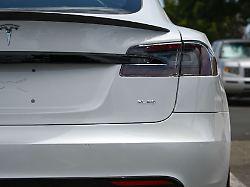New US guidelines on calculation
Tesla is reducing the range of its fleet
January 9, 2024, 8:39 p.m
A new guideline from the US Environmental Protection Agency specifies how electric car manufacturers should calculate the range of their models. Tesla in particular has to rework it again and, according to a media report, is reducing the distances. But other manufacturers could also be affected.
Tesla has lowered the range figures for its entire range of cars. The e-car pioneer responded to new regulations from the US authorities for corresponding measurements following media reports, expert reports and customer complaints about optimistic range estimates.
The changes result from a comparison by the Reuters news agency of the current information on the US group’s website with earlier saved versions. There is no statement from Tesla yet. The change put pressure on the share price of Elon Musk’s company on the New York Stock Exchange.
Some of the changes are comparatively small. For the Model For the Model S Plaid, on the other hand, the value given by Tesla fell from 396 to 359 miles (around 637 to around 578 kilometers). It is unclear whether every sub-variant of every model will be affected by the changes.
Other electric car manufacturers were also affected
The US Environmental Protection Agency (EPA)’s new regulations for 2024 require that the expected range of electric cars be specified according to their “default” mode, i.e. the setting that the vehicle adopts after it is switched on. If there is no such mode, an average must be formed between the best and worst case.
The EPA adopted the new regulations in 2022. The other electric car manufacturers are also affected. However, a Ford spokesman said estimates for the US company’s electric models – including the F-150 Lightning pickup – had not been changed. There are no statements from GM and Hyundai yet.
The editor-in-chief of the trade magazine “Edmunds”, Alistair Weaver, viewed Tesla’s changes as an important step for car buyers. “All eight Tesla vehicles we tested did not meet the EPA estimates,” he said of the previous standard. The head of the analysis company Recurrent, Scott Case, agreed with him: Tesla’s estimates in the past were “30 percent or more more optimistic than the actual range of the vehicles.”
The range of an electric car, especially in the USA, is one of the most important criteria for consumers when deciding which vehicle they buy or whether they buy an electric car at all. In the country, which has an area 27 times the size of the Federal Republic, the term “range anxiety” – in German, “range anxiety” – is used to describe the worry about whether you can make it to the next charging station.
Apparently deliberately “rosy” forecasts
During its research in the summer, Reuters learned from insiders that Tesla deliberately showed drivers “rosy” forecasts for the distance for marketing reasons. In addition, a special “Diversion Team” was secretly formed in 2022 to prevent customers with range complaints from making a maintenance appointment. Tesla declined to comment on the Reuters report.
The author of one of the studies on the range of electric cars, industry veteran Gregory Pannone, emphasized at the time that he was not accusing Tesla of fraud. The company is simply the most “aggressive” in calculating the range according to current EPA regulations. Tesla also carries out additional range tests on all models. In contrast, many other automakers, including Ford, Mercedes and Porsche, relied on an EPA formula to calculate the potential range of their electric cars, according to data for 2023 models. This usually leads to more conservative estimates.
